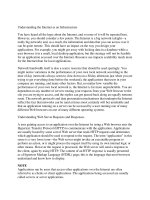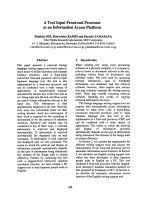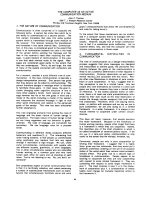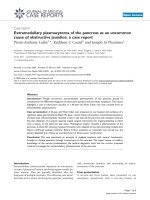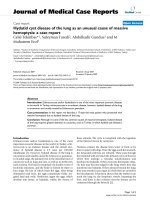the computer as an information tool
Bạn đang xem bản rút gọn của tài liệu. Xem và tải ngay bản đầy đủ của tài liệu tại đây (1.08 MB, 11 trang )
WELCOME TO OUR PRESENTATION
•
TOPIC: THE COMPUTER AS
AN INFORMATION TOOL
•
•
Online literature searches were the accepted way for all research to conduct
systematic reviews of work in particular fields or topics.
•
It is called online because users connect to remote databases to access machine-
readable information stored on large computers frequently located in interstates or
overseas using a personal computer modem and telephone lines.
•
The information is available virtually instantly and may be downloaded to the user’s
computer
•
Major information provider: Dialog, Presscom,…
2. CD-ROM Databases (storing and retrieving information)
Computer is a virtual library and rich storehouse of electronic information resources
1. Online literature searches:
•
Structure:
•
CD-ROM holds staggering amounts of information which can only be read ,not
amended or added
•
CD-ROM contains sound, pictures, animation and text; contains the complete
unabridged text of nearly 2000 classic work(essays, letters, poems,…) together with
pictures and narrations.
•
Functions :
•
CD-ROM is medium for many information services because of its vast storage
capacity.
•
It is powerful research tool which helps the researcher interacts directly with the
information base
•
another type: Bookshelf-a library of reference tools for writers
3. Electronic reference library
•
The original online literature searches remote
databases via modem and telephone
•
Technology from SilverPlatter called Electronic
Reference Library(ERL) which contains software and
protocols in order to make available the most widely
that were previously available on CD-ROM over their
campus networks.
•
SPIRS ( SilverPalatter Information Retrieval System) is
currently the most widely used search and retrieval
software in the world.
With the internet and world wide web, researchers, students and individuals in the
community now have at their fingertips the resources of a worldwide storehouse of
information. Through the web, or with specialist software, users may also send
messages electronically (email) to colleagues or fellow students almost anywhere in the
world. So distance ceases to be a barrier.
THE INTERNET AND THE WORLD WIDE WEB
World wide web is the information that resides on all of interconnection of computers across the
globe, an enormous information resource that may be described as the world’s largest library.
Internet is the interconnection of computers across the
globe.
Through world wide web (www) , a rapidly accumulating store of information can be accessed
that was previously located in millions of separate titles in individual libraries throughout the
world.
The web also contains a rich store of up-to-the-minute information from news and other media
sources.
Often web leads other mass media with news-breaking events.
The information in the web is available anywhere, anytime, to those with the appropriate tools:
hardware, software and know-how.
You have to know the locations or addresses of Web pages or in some page of a website.
It is often useful to know where a web page comes from.
CAUTIONS WITH WEB MATERIALS.
First, the web contains an immense about of trivia (too normal) , much information is transient
(temporator) and some is biased(unequal) or in accurate, offensive( dislawyal), dangerous. What
is important for researchers and students is to evaluate critically all information .
Secondly, the difficulty in how to cite online information sources in assignments and theses
because of the evolving of online sources.
Finally, at times the internet is slow.
FINDING YOUR WAY AROUND THE WEB
For example: some URL ( a uniform resource locator) that allow your network browser to locate
website easily.
www: indicates the server on world wide web
http: indicates a the internet protocol for transferring information.
Types of organization :
Com: commercial
Edu: education
Two digit country code:
Au: australia
Id:indonesia
So on.
Thirdly, the potential danger about web materials is the critical need to acknowledge sources to
avoid plagiarism.
SEARCHING THE WEB
How do you find specific information then when your assignment or thesis has strictly imposed
deadlines?
Fortunately,there are search engines to help. Search engines are rather like machines that trawl
the net in response to specific requests for information.
Already there are many competing search engines from which to choose .
Among the better known search engines are Lycos, Webcrawler, Yahoo!,Hotbot, Excite and Alta
Vista.
Simple Searches
When you search with AltaVista, you may choose between what is called Simple Search and
Advanced Search.
Advanced Searches
Advanced Searches with AltaVista are
characterised by the use of the Boolean
operators AND, OR and NOT(+,- in Simple
Search) and the operator Near.
Because of the popularity of the Internet and its ease of use, many commercial
information providers are making materials available( for a fee) to online searching.
LEARNING ON THE NET
In its role as an information tool, the Web is widely used to present information the Internet itself
and about internet tools and protocols.
With the realisation that the Web is a power ful information tool, more and more universities and
TAFE colleges are offering selected courses online.
ONLINE DATABASES
Some useful online databases:
Current Contents which indexes the contents of
approximately 7000 journals in arts and
humanities, science, and social sciences.
Lexis – Nexis, a fully searchable database
containing the complete text of many
newspapers around the word and a large
number of journals across a range of
disciplines.
FirstSearch which includes a number of
periodical indexes and databases of abstracts.
. The computer becomes an indispensable research tool.
INDISPENSABLE RESEARCH TOOL
Certainly the rapid expansion of the internet and its widespread acceptance is due to the seamless
way that Network browers such as Netscape enable users to navigate the World Wide Web
without the need for arcane instructions or detailed knowledge of computer protocols.
Literature searching, once the preserve of highly trained librarians, is a skill that students can,
with help, develop themselves
No longer are students and researchers bound by their locally based libraries. With appropriate
technology such as Electronic referance library and access to the Internet, students completing
assignments and theses can search for and retrieve electronic information across institutions and
accross worldwide networks.
THE END
THANK FOR YOUR
LISTENING
